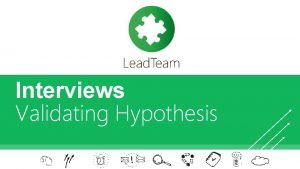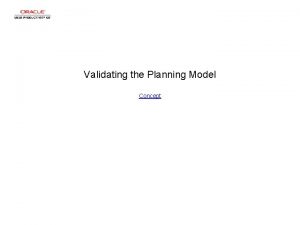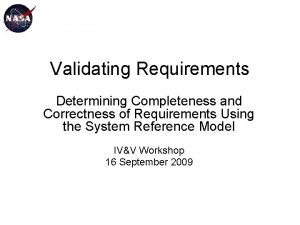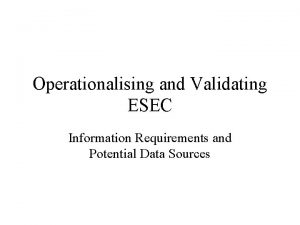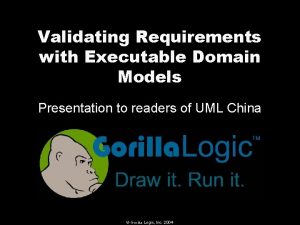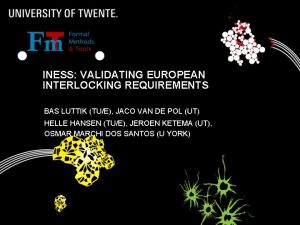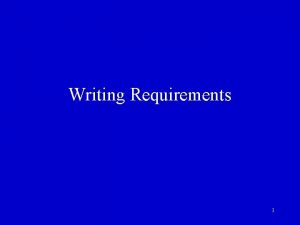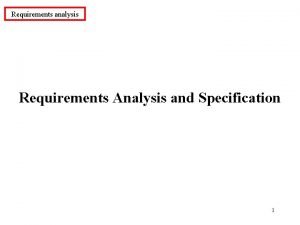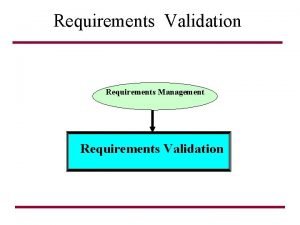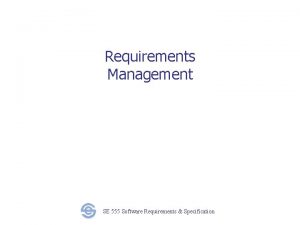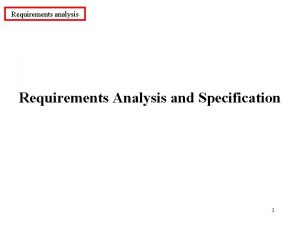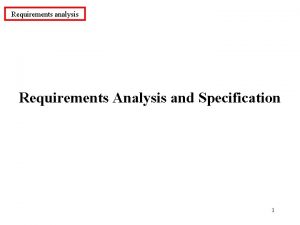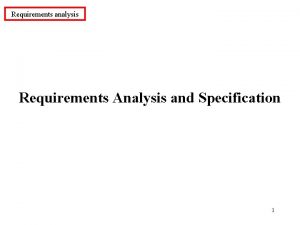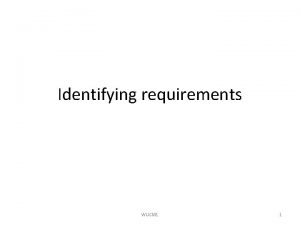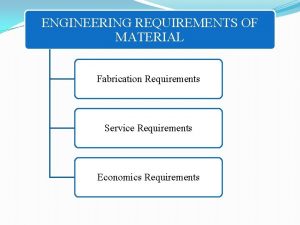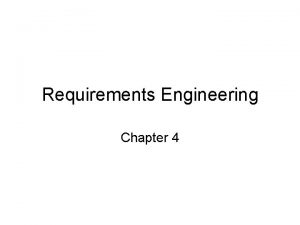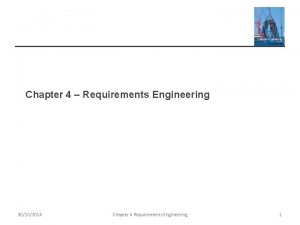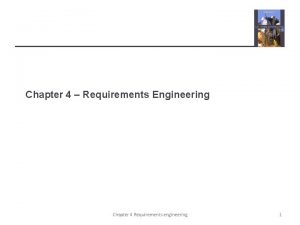1 Chapter 15 VALIDATING THE REQUIREMENTS 2 Overview





























- Slides: 29

1 Chapter 15: VALIDATING THE REQUIREMENTS

2 Overview Studies have shown that it can cost approximately 100 times more to correct a customerreported requirement defect than to correct an error found during requirements development. (Boehm 1981; Grady 1999) Most software developers have experienced the frustration of being asked to implement requirements that were ambiguous or incomplete. If they can't get the information they need, the developers have to make their own interpretations, which aren't always correct. Extensive effort is needed to fix requirement errors after work based on those requirements has already been completed.

3 Overview Testing is a late-stage activity so requirements-related problems linger in the product until they're finally revealed through time-consuming system testing or by the customer. If you start test planning and test-case development early, you'll detect many errors & this prevents from further damage and reduces your testing and maintenance costs.

4 Overview Requirements validation is the fourth component—with elicitation, analysis, and specification— of requirements development (Abran and Moore 2001). Requirements validation activities attempt to ensure that: 1. The SRS correctly describes the intended system capabilities and characteristics that will satisfy the various stakeholders' needs. 2. The software requirements were correctly derived from the system requirements, business rules, or other sources. 3. The requirements are complete and of high quality. 4. All requirements representations are consistent with each other. 5. The requirements provide an adequate basis to proceed with design and construction.

5 Overview Validation ensures that the requirements exhibit the desirable characteristics of 1. Excellent requirement statements (complete, correct, feasible, necessary, prioritized, unambiguous, and verifiable) 2. And excellent requirements specifications (complete, consistent, modifiable, and traceable, quantifiable).

6 Overview Some authors use the term verification for this step (Thayer and Dorfman 1997). Verification determines whether the product of a development activity meets the requirements established for it (doing the thing right). Validation assesses whether a product actually satisfies the customer needs (doing the right thing).

7 Reviewing Requirements Any time someone other than the author of a software work product examines the product for problems, a peer review is taking place. Reviewing requirements documents is a powerful technique for identifying ambiguous or unverifiable requirements, requirements that aren't defined clearly enough for design to begin, and other problems.

8 Peer Review- Informal reviews are useful for educating other people about the product and collecting unstructured feedback. However, they are not systematic, thorough, or performed in a consistent way. Informal review approaches include: 1. A peer desk-check, in which you ask one colleague to look over your work product 2. A pass-around, in which you invite several colleagues to examine a deliverable concurrently 3. A walkthrough, during which the author describes a deliverable and asks comments on it

9 Peer Review- Formal reviews Formal peer reviews follow a well-defined process. A formal review produces a report that identifies the material, the reviewers, and the review team's judgment as to whether the product is acceptable. The basic deliverable is a summary of the defects found and the issues raised. The members of a formal review team share responsibility for the quality of the review, although authors are ultimately responsible for the quality of the products they create. (Freedman and Weinberg 1990)

10 Peer Review- Formal reviews The best-established type of formal peer review is called an inspection. (Gilb and Graham 1993; Radice 2002) Inspection of requirements documents is arguably the highest-leverage software quality technique available. Several companies have avoided as much as 10 hours of labor for every hour they invested in inspecting requirements documents and other software deliverables

11 Peer Review- Formal reviews For maximizing the quality of your software, your team will inspect every version of requirements document it creates. Detailed inspection of large requirements documents is tedious and time consuming.

12 The Inspection Process Michael Fagan developed the inspection process at IBM in the mid-1970 s (Fagan 1976), and others have extended or modified his methods (Gilb and Graham 1993). Any software work product can be inspected, including requirements and design documents, source code, test documentation, and project plans.

13 The Inspection Process - Participants It involves a small team of trained participants who carefully examine a work product for defects and improvement opportunities. The participants in an inspection should represent four perspectives (Wiegers 2002 a): 1. 2. The author of the work product and perhaps peers of the author The author of any predecessor work product or specification for the item being inspected 3. People who will do work based on the item being inspected 4. People who are responsible for work products that interface with the item being inspected

14 The Inspection Process - Roles Author The author created or maintains the work product being inspected. The author of an SRS is usually the analyst who gathered customer requirements and wrote the specification. During informal reviews such as walkthroughs, the author often leads the discussion. However, the author takes a more passive role during an inspection, the author can listen to the comments from other inspectors, respond to—but not debate—their questions, and think. The author will often spot errors that other inspectors don't see.

15 The Inspection Process - Roles Moderator The moderator, or inspection leader, plans the inspection with the author, coordinates the activities, and facilitates the inspection meeting. The moderator distributes the materials to be inspected to the participants before the inspection meeting. Moderator responsibilities include starting the meeting on time, encouraging contributions from all participants, and keeping the meeting focused. Reporting the inspection results to management. The moderator follows up on proposed changes to ensure that the defects and issues were addressed properly.

16 The Inspection Process - Roles Reader One inspector is assigned the role of reader. During the inspection meeting, the reader paraphrases the SRS one requirement at a time. The other participants then point out potential defects and issues. By stating a requirement in his/her own words, the reader provides an interpretation that might differ from that held by other inspectors. This is a good way to reveal an ambiguity, a possible defect, or an assumption.

17 The Inspection Process - Roles Recorder The recorder, or scribe, uses standard forms to document the issues raised and the defects found during the inspection meeting. The recorder should review aloud what he wrote to confirm the record's accuracy. The other inspectors should help the recorder capture the essence of each issue in a way that clearly communicates to the author the location and nature of the issue.

18 The Inspection Process - Entry Criteria You're ready to inspect a requirements document when it satisfies specific prerequisites. These entry criteria set some clear expectations, that should be resolved prior to the inspection. The moderator uses the entry criteria as a checklist before deciding to proceed with the inspection. Following are some suggested inspection entry criteria for requirements documents: 1. The document conforms to the standard template. 2. The document has been spell-checked. 3. The author has visually examined the document for any layout errors.

19 The Inspection Process - Entry Criteria 4. Any predecessor or reference documents that the inspectors will require to examine the document are available. 5. Line numbers are printed on the document to facilitate referring to specific locations during the inspection meeting. 6. All open issues are marked as TBD (to be determined).

20 The Inspection Process - Stages Inspection is a multistep process. The dotted lines indicate that portions of the inspection process might be repeated.

21 The Inspection Process - Planning The author and moderator plan the inspection together. They determine who should participate, what materials the inspectors should receive prior to the inspection meeting, and how many inspection meetings will be needed to cover the material.

22 The Inspection Process - Overview meeting During the overview meeting, the author describes the background of the material the team will be inspecting, any assumptions he made, and his specific inspection objectives. You can omit this stage if all inspectors are already familiar with the items being inspected.

23 The Inspection Process - Preparation Prior to the inspection meeting, each inspector examines the product to identify possible defects and issues to be raised, using the checklists of typical defects described or other analysis techniques (Wiegers 2002 a). Up to 75 percent of the defects found by an inspection are discovered during preparation (Humphrey 1989), so don't omit this step. Written SRS can never replace clarifying discussions between project participants.

The Inspection Process - Inspection meeting 24 During the inspection meeting, the reader leads the other inspectors through the SRS, describing one requirement at a time. As inspectors bring up possible defects and other issues, the recorder captures them on a form that becomes the action item list for the requirements author. The inspection meeting shouldn't last more than about two hours because tired people aren't effective inspectors. . At the meeting's conclusion, the team decides whether to accept the requirements document as is, accept it with minor revisions, or indicate that major revision is needed. An outcome of major revision needed indicates problems with the requirements development process.

The Inspection Process - Inspection meeting Sometimes inspectors are easily sidetracked into discussing whether an issue really is a defect, debating questions of project scope, and brainstorming solutions to problems. 25 These activities are useful, but they distract attention of finding significant defects and improvement opportunities. I've found that the meetings can reveal additional defects that no inspectors found during their individual preparation.

26 The Inspection Process - Rework Nearly every quality control activity reveals some defects. The author should spend some time reworking the requirements. Uncorrected requirement defects will be expensive to fix down the road, so this is the time to resolve the ambiguities and lay the foundation for a successful development project.

27 The Inspection Process - Follow-up In this final inspection step, the moderator or a designated individual works with the author to ensure that all open issues were resolved and that errors were corrected properly. Follow-up brings closure to the inspection process and enables the moderator to determine whether the inspection's exit criteria have been satisfied.

28 The Inspection Process - Exit Criteria Your inspection process should define the exit criteria that must be satisfied before the inspection complete. Here are some possible exit criteria for requirements document inspections: 1. All issues raised during the inspection have been addressed. 2. Any changes made in the document and related work products were made correctly. 3. The revised document has been spell-checked. 4. All TBDs have been resolved, or each TBD's resolution process, target date, and owner has been documented.

29 Defining Acceptance Criteria Software developers might believe that they've built the perfect product, but the customer is the final arbiter. Customers perform acceptance testing to determine whether a system satisfies its acceptance criteria (IEEE 1990) Acceptance criteria—and hence acceptance testing—should evaluate whether the product satisfies its documented requirements and whether it is fit for use in the intended operating environment. (Hsia, Kung, and Sell 1997)
 Validating hypothesis
Validating hypothesis Hình ảnh bộ gõ cơ thể búng tay
Hình ảnh bộ gõ cơ thể búng tay Slidetodoc
Slidetodoc Bổ thể
Bổ thể Tỉ lệ cơ thể trẻ em
Tỉ lệ cơ thể trẻ em Gấu đi như thế nào
Gấu đi như thế nào Tư thế worm breton là gì
Tư thế worm breton là gì Chúa yêu trần thế
Chúa yêu trần thế Môn thể thao bắt đầu bằng chữ f
Môn thể thao bắt đầu bằng chữ f Thế nào là hệ số cao nhất
Thế nào là hệ số cao nhất Các châu lục và đại dương trên thế giới
Các châu lục và đại dương trên thế giới Công thức tính độ biến thiên đông lượng
Công thức tính độ biến thiên đông lượng Trời xanh đây là của chúng ta thể thơ
Trời xanh đây là của chúng ta thể thơ Mật thư anh em như thể tay chân
Mật thư anh em như thể tay chân Phép trừ bù
Phép trừ bù độ dài liên kết
độ dài liên kết Các châu lục và đại dương trên thế giới
Các châu lục và đại dương trên thế giới Thơ thất ngôn tứ tuyệt đường luật
Thơ thất ngôn tứ tuyệt đường luật Quá trình desamine hóa có thể tạo ra
Quá trình desamine hóa có thể tạo ra Một số thể thơ truyền thống
Một số thể thơ truyền thống Cái miệng nó xinh thế
Cái miệng nó xinh thế Vẽ hình chiếu vuông góc của vật thể sau
Vẽ hình chiếu vuông góc của vật thể sau Nguyên nhân của sự mỏi cơ sinh 8
Nguyên nhân của sự mỏi cơ sinh 8 đặc điểm cơ thể của người tối cổ
đặc điểm cơ thể của người tối cổ Thế nào là giọng cùng tên
Thế nào là giọng cùng tên Vẽ hình chiếu đứng bằng cạnh của vật thể
Vẽ hình chiếu đứng bằng cạnh của vật thể Tia chieu sa te
Tia chieu sa te Thẻ vin
Thẻ vin đại từ thay thế
đại từ thay thế điện thế nghỉ
điện thế nghỉ
